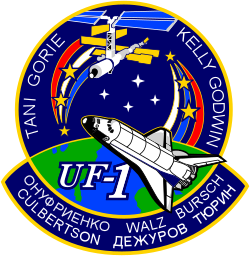Juri Iwanowitsch Onufrijenko
| Juri Onufrijenko | |
|---|---|
 | |
| Land | Russland |
| Organisation | Roskosmos |
| ausgewählt | 25. Januar 1989 |
| Einsätze | 2 Raumflüge |
| Start des ersten Raumflugs | 21. Februar 1996 |
| Landung des letzten Raumflugs | 19. Juni 2002 |
| Zeit im Weltraum | 389d 14h 46min |
| EVA-Einsätze | 8 |
| EVA-Gesamtdauer | 42h 32min |
| ausgeschieden | März 2004 |
| Raumflüge | |
| |
Juri Iwanowitsch Onufrijenko (russisch Юрий Иванович Онуфриенко, wiss. Transliteration Jurij Ivanovič Onufrienko; * 6. Februar 1961 in Ryasnoe, Oblast Charkiw, Ukrainische SSR) ist ein ehemaliger russischer Kosmonaut ukrainischer Herkunft.
Onufrijenko beendete 1982 die Hochschule für Piloten der Luftstreitkräfte „W.M. Komarow“ in Jeisk mit einem Pilot-Ingenieurdiplom. Danach diente er bis zu seinem Eintritt in das Kosmonautenkorps in der sowjetischen Luftwaffe. Er hat über 800 Flugstunden auf den verschiedensten Flugzeugen wie Aero L-29, Suchoi Su-7, Suchoi Su-17 (M1-4) und Aero L-39 gesammelt.
Als potentieller Kosmonaut wurde er 1989 ausgewählt. 1994 machte Onufrijenko einen Abschluss in Kartografie an der Moskauer Lomonossow-Universität.
Im Oktober 1996 wurde Onufrijenko durch einen Erlass des damaligen russischen Präsidenten, Boris Jelzin, die Auszeichnung Held der Russischen Föderation verliehen.[1]
Siehe auch
Weblinks
- Biografie von Juri Iwanowitsch Onufrijenko beim Juri-Gagarin-Kosmonautentrainingszentrum (russisch)
- Biografie von Juri Iwanowitsch Onufrijenko in der Encyclopedia Astronautica (englisch)
- Kurzbiografie von Juri Iwanowitsch Onufrijenko bei spacefacts.de
Einzelnachweise
- ↑ Онуфриенко Юрий Иванович bei warheroes.ru (russisch)
| Personendaten | |
|---|---|
| NAME | Onufrijenko, Juri Iwanowitsch |
| ALTERNATIVNAMEN | Онуфриенко, Юрий Иванович (russisch) |
| KURZBESCHREIBUNG | russischer Kosmonaut ukrainischer Herkunft |
| GEBURTSDATUM | 6. Februar 1961 |
| GEBURTSORT | Ryasnoe, Oblast Charkiw, Ukrainische SSR |
Auf dieser Seite verwendete Medien
Cosmonaut Yuri I. Onufrienko of Rosaviakosmos will serve as commander of Expedition Four at the end of 2001 and the first part of 2002.
This is the mission patch of STS-108. Space Shuttle Endeavour is seen approaching the International Space Station. Two astronaut symbols represent the crew commanders of both ISS expeditions. The ascending one represents cosmonaut Yury Onufriyenko of Russia. (The ascending astronaut symbol shows a flag of Russia.) The descending astronaut symbol represents Frank Culbertson of the USA. This represents crew rotation, as three stars are depicted on the symbols. The space shuttle crew members are depicted along the border while the ISS crews are depicted along the chevron on the border of the patch.
- This is the insignia for the STS-108 mission, which marks a major milestone in the assembly of the International Space Station (ISS) as the first designated Utilization Flight, UF-1. The crew of Endeavour will bring the Expedition Four crew to ISS and return the Expedition Three crew to Earth. Endeavour will also launch with a Multi-Purpose Logistics Module (MPLM) that will be berthed to ISS and unloaded. The MPLM will be returned to Endeavour for the trip home and used again on a later flight. The crew patch depicts Endeavour and the ISS in the configuration at the time of arrival and docking. The Station is shown viewed along the direction of flight as will be seen by the Shuttle crew during their final approach and docking along the X-axis. The three ribbons and stars on the left side of the patch signify the returning Expedition Three crew. The red, white and blue order of the ribbons represents the American commander for that mission. The three ribbons and stars on the right depict the arriving Expedition Four crew. The white, blue, red order of the Expedition Four ribbon matches the color of the Russian flag and signifies that the commander of Expedition Four is a Russian cosmonaut. Each white star in the center of the patch represents the four Endeavour crew members. The names of the four astronauts who will crew Endeavour are shown along the top border of the patch. The three astronauts and three cosmonauts of the two expedition crews are shown on the chevron at the bottom of the patch.
The International Space Station (ISS) Expedition Four crew patch has an overall diamond shape, showing the "diamond in the rough" configuration of the Station during expedition four. The red hexagonal shape with stylized American and Russian flags represents the cross-sectional view of the S0 truss segment, which the crew will attach to the U.S. Lab Destiny. The persistent Sun shining on the Earth and Station represents the constant challenges that the crew and ground support team will face every day while operating the International Space Station, while shedding new light through daily research. The green portion of the Earth represents the fourth color in the visible spectrum and the black void of space represents humankind's constant quest to explore the unknown.
The official crew patch for the Russian Soyuz TM-23 mission, which delivered the EO-21 crew to the space station Mir.




